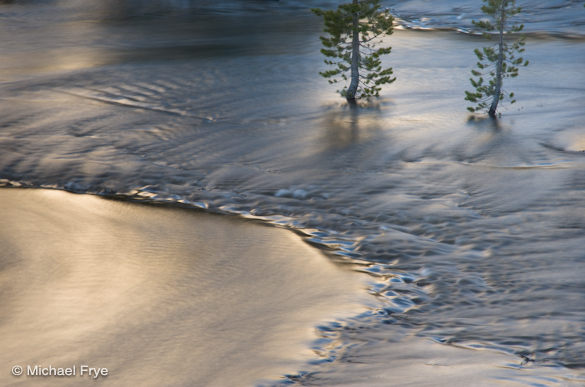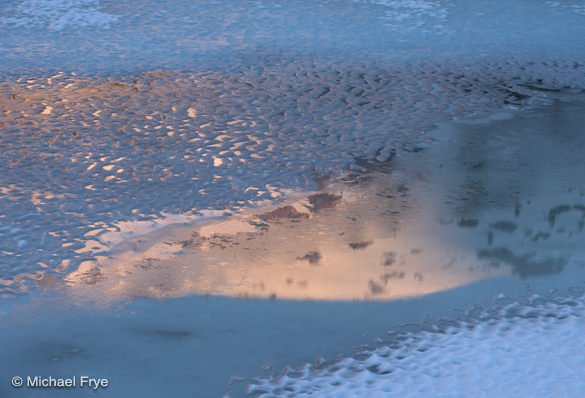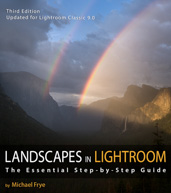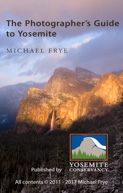Yosemite Photo Conditions
by Michael Frye | Aug 5, 2010 | Yosemite Photo Conditions
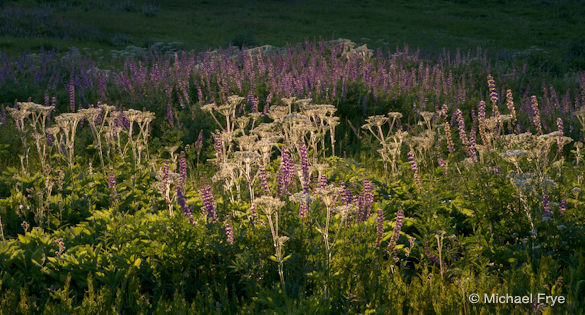
Lupine and cow parsnip near the Glacier Point Road last Sunday
As expected, the wildflowers are nearing their peak in the higher elevations of Yosemite. They’re not really late; this is typical timing after a heavy winter. A fleeting, beautiful period of time has begun.
Summit Meadow, right along the Glacier Point Road, is a damp, boggy place. As the meadow slowly dries out over the summer, the shooting stars that dominated the early-season landscape give way to corn lilies, sneezeweed and lupine. There should be a nice mix of flowers there by this weekend. There are also many other small meadows and clearings near this road with flowers—you just have to look. It might also be worth a short hike to McGurk or Westfall meadows. A couple of years ago Claudia and I arranged a car shuttle and hiked from Taft Point to the McGurk Meadow trailhead, and found lots of great flowers along the way.
Speaking of Claudia, there’s a photo of her below near Crane Flat, standing next to the tallest corn lily I’ve ever seen. Ten feet tall? It’s a good year for corn lilies. In some summers a cold snap kills them before they bloom, but while we had a late spring, the temperatures have been moderate since early June, and corn lily blossoms are abundant right now. Some are already spent at Crane Flat, at only 6000 feet in elevation, but at 7000 feet and higher they should still be going strong for another week or so.
Other flowers, however, are still blooming at Crane Flat. Last Thursday the sneezeweed, coneflowers, and lupine were abundant, and other blossoms like yampah and goldenrod were about to bloom in big numbers.
I haven’t been to Tuolumne Meadows recently, but Claudia has, and says the wildflower display is typical of recent years—scattered blooms, but no thick carpets of flowers. However she found more color in other places, like along the trail to Mono Pass. It’s likely that other spots near Tioga Pass have good displays as well.
Please be careful when photographing wildflowers, and try not to trample them in your efforts to find the perfect composition. We want them to bloom next year too!
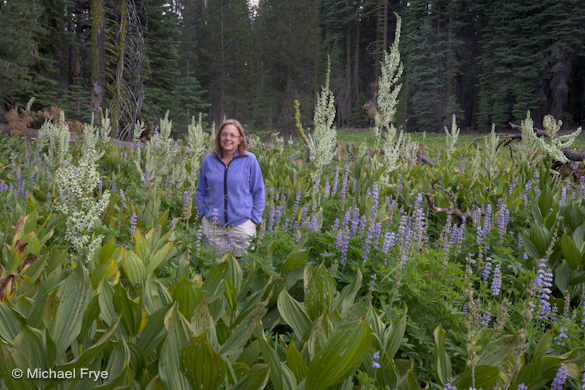
Claudia next to the tallest corn lily I’ve ever seen
by Michael Frye | Jul 23, 2010 | Yosemite Photo Conditions
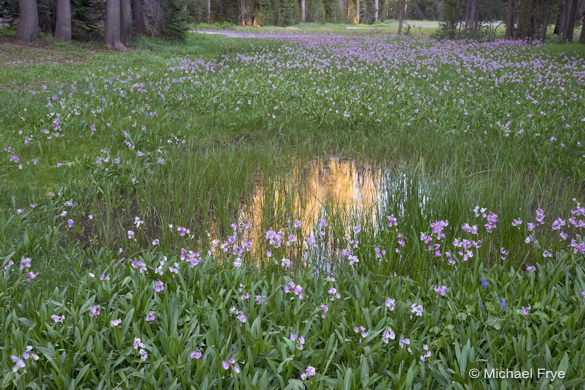
Pond and shooting stars along the Glacier Point Road
It’s late July, and spring is long gone from the Sierra foothills, where I live, and in most of California—indeed, most of the United States. But in the high elevations of the Sierra Nevada the wildflowers are just getting started. Shooting stars are abundant right now between 7000 and 9000 feet in Yosemite. I made the photograph above near the Glacier Point Road last Sunday. But shooting stars are early bloomers, and the rest of the high-country flowers are only beginning to emerge. The peak bloom at these elevations will probably arrive in early August.
Wildlfowers in August? Absolutely. Flowers bloom late in the mountains—in fact one of the best wildflower displays I’ve seen in Yosemite occurred in September after an exceptionally heavy winter.
The best places to look for flowers are often small meadows at around 7000 to 8000 feet. Many areas along the Glacier Point Road fit this description, including Summit Meadow, right next to the road, and McGurk Meadow, which requires a short hike. Naturally these areas are described in my book, the Photographer’s Guide to Yosemite—Location 21 (click here to purchase a signed copy directly from me). (more…)
by Michael Frye | Jul 5, 2010 | Yosemite Photo Conditions
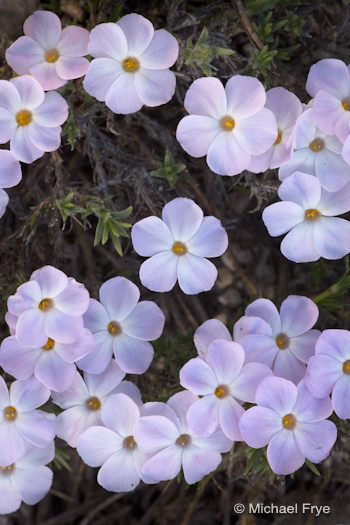 Claudia and I spent Fourth of July weekend in the Yosemite High Country, scouting for my upcomingHidden Yosemite workshop. There’s still plenty of water flowing in the creeks and rivers, and some big reflecting ponds remain in the west end of the main Tuolumne Meadow. Some flowers have appeared, like the spreading phlox shown here, penstemon along the side of the Tioga Pass Road between Yosemite Creek and Olmsted Point, and a few patches of shooting stars in damp meadows. I’m sure more flowers will be blooming soon. It promises to be a good wildflower year in the high country, but the peak probably won’t arrive until at least early August.
Claudia and I spent Fourth of July weekend in the Yosemite High Country, scouting for my upcomingHidden Yosemite workshop. There’s still plenty of water flowing in the creeks and rivers, and some big reflecting ponds remain in the west end of the main Tuolumne Meadow. Some flowers have appeared, like the spreading phlox shown here, penstemon along the side of the Tioga Pass Road between Yosemite Creek and Olmsted Point, and a few patches of shooting stars in damp meadows. I’m sure more flowers will be blooming soon. It promises to be a good wildflower year in the high country, but the peak probably won’t arrive until at least early August.
My nickname for shooting stars is “mosquito flowers,” because they grow in boggy areas and always seem to blossom at the same time as the mosquitos. Just the sight of shooting stars makes me itchy. And sure enough, the mosquitos were out, but we didn’t encounter any maddening, intolerable swarms. I’m keeping my fingers crossed, hoping that these little pests won’t be too bad this year, but it’s probably just a little too early for them at the higher elevations. But even clouds of mosquitos won’t keep me away—the high country is just too beautiful to miss.
by Michael Frye | Jun 21, 2010 | Yosemite Photo Conditions
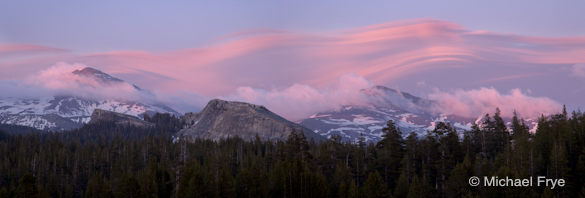
Lenticular cloud above Mounts Dana and Gibbs
Saturday Claudia and I drove up to Tuolumne Meadows. There was still lots of snow in the high country—not as much as when the pass first opened, of course, but plenty. We hiked around Pothole Dome to the place where the Tuolumne River starts to tumble down from the west end of the meadows, as I wanted to photograph these cascades with high water. We had the place to ourselves and it was beautiful. Claudia took a short video of that upper cascade, which I posted on Facebook.
We kept our eyes on a big lenticular cloud that had formed over the mountains to the north, but it seemed to dissipate near the end of the day. As we walked back up to the main meadow near sunset, however, we saw that a smaller lenticular cloud was riding above Mt. Gibbs, so we rushed to a spot closer to the road and caught the last sunset light on the mountains. I assembled the panorama above from two images zoomed in on the peaks.
We didn’t get home until 11 p.m., but it was worth it. We had a great afternoon in a special place.
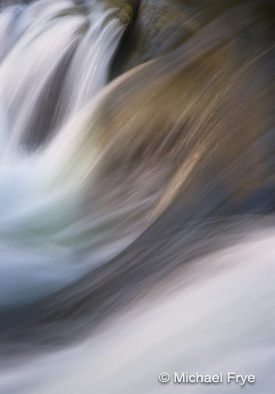
Water leaving Tuolumne Meadows (this is the cascade in the video)
by Michael Frye | Jun 12, 2010 | Yosemite Photo Conditions
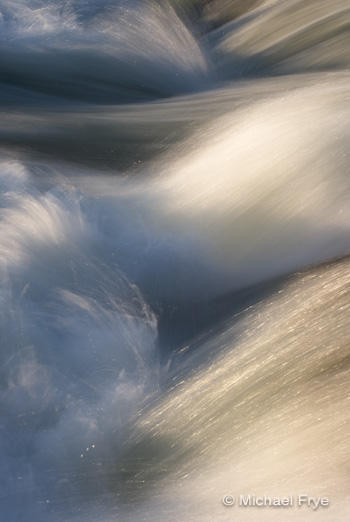 While the snow at high elevations in Yosemite is melting rapidly, there’s still plenty around,enough to keep the water flow high as it melts. While the snow at high elevations in forecast calls for warmer temperatures Sunday and Monday, so the water volume in Yosemite Valley should increase—maybe not to the level we saw last weekend, but close. After that, temperatures are supposed to cool down again, so that may be the end of the highest water this year, as most of the snow will be gone soon.
While the snow at high elevations in Yosemite is melting rapidly, there’s still plenty around,enough to keep the water flow high as it melts. While the snow at high elevations in forecast calls for warmer temperatures Sunday and Monday, so the water volume in Yosemite Valley should increase—maybe not to the level we saw last weekend, but close. After that, temperatures are supposed to cool down again, so that may be the end of the highest water this year, as most of the snow will be gone soon.
by Michael Frye | Jun 7, 2010 | Yosemite Photo Conditions
Flooded lodgepole pines along Tenaya Creek
My wife Claudia and I drove over Tioga Pass on Saturday, the first day the road was open this year. There’s a lot of snow up there! Patches of bare ground were scarce, and in some places the snow was still five or six feet deep. Tenaya, Tioga, and Ellery Lakes were still mostly frozen.
We arrived at our home-away-from-home, Murphey’s Motel in Lee Vining, at about 4 p.m. Around seven o’clock, as we drove back over the pass for some photography, we noticed that a large avalanche had covered part of a snow basin just east of Ellery Lake. We had both looked at that slope three hours earlier, and hadn’t seen evidence of an avalanche, so it had apparently fallen within that time.
All the snow was melting fast, and water was everywhere. I saw waterfalls I don’t remember seeing before, and innumerable creeks, streams, and ponds. Just above Tenaya Lake I found a spot where swollen Tenaya Creek had enveloped a stand of lodgepole pines, with the water reflecting a sunlit ridge above.
The next morning we rose early and drove up to Tioga Lake, where I photographed snowy peaks reflected in the partially frozen lake, and wonderful ice patterns near the shore. Of course I got too near the edge and received a boot full of water when one of my feet broke through the ice to the lake below.
With the opening of this road the Yosemite high country will be more easily accessible throughout the summer and fall, providing access to many great photo locations. But the snow and ice won’t last long.
We didn’t get into Yosemite Valley, but I’m sure it’s beautiful, with the waterfalls roaring and the meadows flooded. Did any of you make it into the valley this weekend?
Gaylor Peak reflected in Tioga Lake








